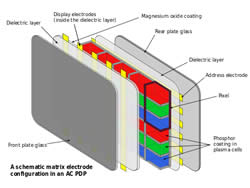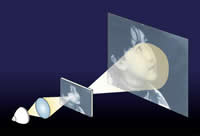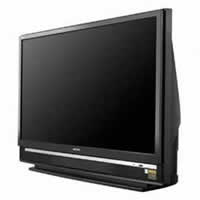Difference Between Plasma and Projection TVs
Key Difference: Plasma TVs are a flat panel displays that use noble gases in order to produce light and images. A Projection TV initially creates a small picture and then uses a beam of light in order to enlarge that image on a screen. Projection systems come in two types: front-projection TV and rear-projection TV. A front projection set allows the user to make the projected image as large or as small they want. A rear-projection system and plasma set comes with the set height that the user bought.
Large TVs used to be considered as a luxury, however the trend these days is ‘bigger is better’. Plasma TVs are a flat panel display that uses noble gases in order to produce light and images. Projection TV technology is used to project images on a big white screen, similar to data projectors, but these projectors are designed to project standard and high definition TV signals.

A plasma display panel has tiny cells of noble gases (neon and xenon) and a small amount of mercury in compartmentalized spaces between two glass panels. The panels also have two electrodes between the glass panels, an address electrode and the display electrodes. The display electrodes are surrounded by an insulating dielectric material and covered by a magnesium oxide protective layer. In order to create the pixels, the address electrode and the display electrodes are charged, which then releases an electric current that flows through the cell. The charge stimulates the gas atoms in the cells to release ultraviolet photons.
The photons interact with the phosphor material on the cell walls and give off light, creating a visible light photon. Each pixel has three subpixels, one coated with red, one with blue and one with green. By manipulating the intensity of the current, the system can produce hundreds of different combinations of the three colors and creates an image on the screen.

Projection TVs have a larger screen compared to Plasma displays. A Projection TV initially creates a small picture and then uses a beam of light in order to enlarge that image on a screen. Projection systems come in two types: front-projection TV and rear-projection TV.
A front-projection TV uses a projector and a separate screen. This set up is similar to the one found in movie theatres. The projector creates a small image and then uses light to enlarge the image on to the screen. The front-projector can either be placed on a table or mounted on the wall. A rear-projection TV looks more like traditional TVs and is huge. The display system of the rear-projector is different from the front-projector. The rear-projector displays images on the back of the screen using a mirror to reflect the image. The projector and the mirror are placed inside the system itself. The rear-projector TV looks like a traditional CRT TV set.

Projection TVs have four types of projection techniques: Cathode Ray Tube (CRT), Liquid Crystal Display (LCD), Digital Light Processing (DLP) and Liquid Crystal over Silicon (LCoS). CRT technique uses cathode ray gun and a color wheel in order to display images on the screen. LCD uses liquid crystal molecules embedded between two polarizing filters and displays images when a charge is passed through the two filters; the crystals allow/block light passing through the filters. DLP uses a digital micromirror device (DMD), a chip mounted with tiny microscopic mirrors, in order to reflect light and create images. The system is also mounted with a color wheel in order to create color images. LCos is a new technology that is a combination of DLP and LCD technology. In an LCos set, light passes through liquid crystals and is then bounced off a reflected surface in order to create an image.
Choosing between a projection system and a plasma TV depends on the buyer’s choice. A front projection set allows the user to make the projected image as large or as small they want. A rear-projection system and plasma set comes with the set height that the user bought. Front projectors require a complete dark room in order to operate, while this is not the case for Plasmas or rear-projection sets. A rear-projection system takes up room, while Plasma and front-projection TVs can be mounted on the wall.
When buying a projection TV, certain things that need to be kept in mind are: the size of the room and the size of the screen, availability of a proper ambiance, compatibility with standard and high-definition set up, the cost of all the components together and normal specifications (contrast ratio, frame rate, resolution, etc).
Image Courtesy: wikimedia.org, howstuffworks.com, presentationtek.com









Add new comment